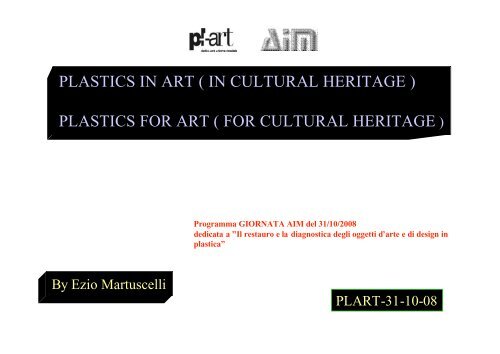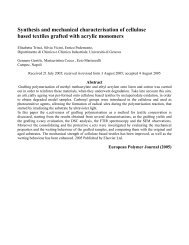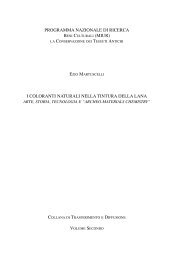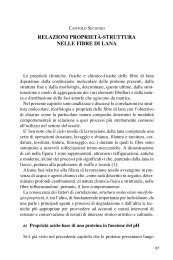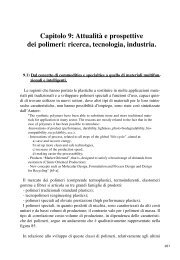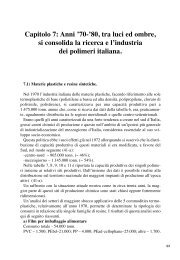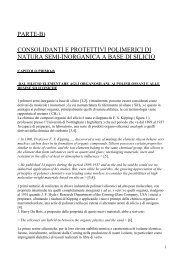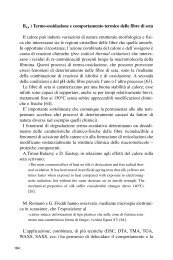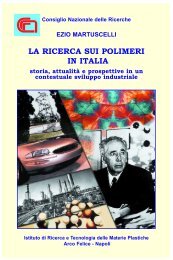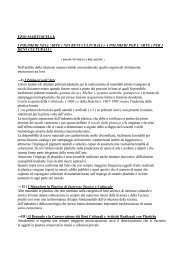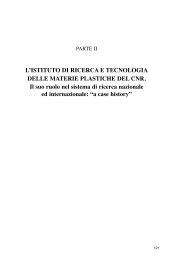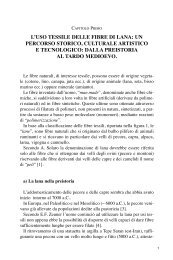Polimero - ezio martuscelli
Polimero - ezio martuscelli
Polimero - ezio martuscelli
Create successful ePaper yourself
Turn your PDF publications into a flip-book with our unique Google optimized e-Paper software.
PLASTICS IN ART ( IN CULTURAL HERITAGE )<br />
PLASTICS FOR ART ( FOR CULTURAL HERITAGE )<br />
Programma GIORNATA AIM del 31/10/2008<br />
dedicata a ”Il restauro e la diagnostica degli oggetti d’arte e di design in<br />
plastica”<br />
By Ezio Martuscelli<br />
PLART-31-10-08
POLYMERS SINCE THE THE BIRTH OF THE<br />
PLASTICS INDUSTRY WERE PREFERRED ,<br />
IN MANY APPLICATIONS, TO TRADITIONAL MATERIALS:<br />
WOOD, METAL, GLASS, CERAMICS, IVORY, ECC:.<br />
THE ADVANTAGES WERE THE FOLLOWING:<br />
---EASY LAVORABILITY<br />
---LOW PRODUCTION COST<br />
---WEIGHT SAVING<br />
---COLORABILITY<br />
---IMPROVED PERFORMANCES ( NOT ALWAYS ).<br />
THE DISAVANTACES OF PLASTICS WERE:<br />
---UNSTABILITY AGAINST DEGRADATION FACTORS<br />
--- NECESSITY TO USE STABILIZERS, PLASTICIZERS AND<br />
OTHER ADDITIVES
PLASTICS=(POLYMERS)+(ADDITIVES, FILLERS, PIGMENTS)<br />
ARE BECOMING AN INCREASING PART OF COLLECTIONS<br />
OF MANY MUSEUMS INCLUDING THE ART MUSEUMS<br />
AND THE SCIENCE MUSEUMS<br />
OF GREAT INTEREST ARE:<br />
---ARTISTIC OBJECTS MADE IN PLASTICS<br />
--- ITEMS OF HISTORICAL AND CULTURAL INTEREST<br />
REALIZED IN PLASTICS<br />
BOTH TYPES BELONG TO THE BROAD FAMILY OF<br />
CULTURAL HERITAGE
PLASTICS IN ART<br />
PLASTICS HAD ( STILL HAVE ) AN IMPORTANT FUNCTION<br />
IN THE STRUCTURATION OF WORKS OF ART.<br />
THEY REPRESENTED ( REPRESENT )<br />
A MEANS OF EXPRESSION OF ARTISTS AND DESIGNERS.<br />
FOR SUCH A REASONS PLASTIC OBJECTS OF ARTISTIC<br />
INTEREST ARE MORE AND MORE PRESENT IN MUSEUM<br />
AND COLLECTIONS
PLASTICS IN ITEMS OF HISTORICAL<br />
AND CULTURAL INTEREST<br />
PLASTICS ARTIFACTS OF HISTORICAL INTEREST ARE<br />
ALSO PRESENT IN MUSEUM AS THEY TESTIFY:<br />
1 ) THE EVOLUTION OF:<br />
--- SCIENCE; TECHNOLOGY AND INDUSTRY;<br />
--- AN INNOVATIVE INDUSTRIAL DESIGN ;<br />
--- THE PRODUCTION OF NEW ADVANCED MATERIALS;<br />
2 ) EVENTS RELEVANT FOR THE HISTORY OF PEOPLES<br />
AND NATIONS<br />
.
J. Morgan-1994<br />
Type of plastic objects breakdown<br />
in museums and private collections
AGE OF OBJECTS<br />
J. Morgan-1994
IT IS USEFUL TO DIVIDE THE PLASTIC ITEMS OF ARTISTIC<br />
OR HISTORICAL INTEREST ACCORDING TO THE NATURE OF<br />
THE POLYMER COMPONENT. SO WE MAY HAVE OBJECTS<br />
MADE BY :<br />
--- NATURAL PLASTICS ( AS EBONITE, SHELLAC, CASEIN )<br />
--- MAN-MADE PLASTICS ( ARTIFICIAL PLASTICS:<br />
AS CELLULOID, CELLULOSE ACETATES )<br />
--- MAN-MADE PLASTICS ( SYNTHETIC PLASTICS:<br />
AS BAKELITE, PVC, PMMA ECC. )
PLASTICS OF CULTURAL, ARTISTIC AND<br />
HISTORICAL INTEREST, MAY BE ALSO<br />
GROUPED ACCORDING TO TYPE OF<br />
FASHIONING USED:<br />
--Carving, Machining or Shaping,<br />
--Casting or Moulding under heat and pressure
PLASTICS IN ART<br />
THE CONTRIBUTION OF PLASTICS AS A MEANS OF<br />
EXPRESSION OF ARTISTS AND THEIR RELEVANT<br />
ROLE IN THE FINE ARTS<br />
ARE ESSENTIALLY RELATED TO THE FOLOWING:<br />
--- easy avaibility :<br />
--- innovative mechanical and chemical characteristics,<br />
--- easy manufacturing and processing<br />
--- easy mouldability- mouldable alternative to carving<br />
--- easy colorability by using pigments<br />
--- relatively low cost
Con la scoperta delle plastiche di sintesi e lo sviluppo di nuovi pigmenti fu possibile<br />
realizzare materiali caratterizzati da una ampia e diversificata gamma di colori.<br />
Sinistra, catalogo della Catalin che commercializzava resine fenoliche ( 1936 ).<br />
Destra, campionario di resine in acetato di vinile
EXAMPLES OF ARTISTIC ITEMS<br />
MADE IN PLASTICS
Early artistic items<br />
innatiral plastics<br />
(ebanite)<br />
1878-1900<br />
Oggetti artistici in plastica naturale, ebanite, prodotti tra<br />
il 1878 e il 1900
Shellac<br />
Early artistic items<br />
in plastics<br />
Sinistra, dagherrotipo, periodo della guerra civile americana ottenuto<br />
per stampaggio per compressione di una miscela di Shellac e segatura.<br />
Destra, dagherrotipo con la rappresentazione dello sbarco di<br />
Colombo. Prodotto da A.S. Pech and Company da una pittura<br />
di John Vanderlyn. Lo stampo è stato preparato e inciso da<br />
F. B. Smith e Hartman
Opera di Naum Gabo ( 1890-1977 ), dal titolo<br />
“Construction in Space with Crystalline Centre” (1938-40 ).<br />
PMMA e CELLULOIDE, 324 x 470 x 220 mm.
THE TRANSPARENT<br />
SCULPTURES IN PMMA<br />
OF Bruce Beasley ( USA ).<br />
Le sculture trasparenti in PMMA, ottenute per colata o casting<br />
da Bruce Beasley ( USA ). Destra, Stamper’s Lighthouse, 1967.<br />
Sinistra, Apolymon,1968-70.
Scultura, “Lot’s Wife”,<br />
ricavata per CARVING da un blocco di polimetilmetacrilato da<br />
A. Fleischmann, ( I.C.I., Plastics Division )
Marcello Morandini,<br />
sculture in plexiglass<br />
PMMA in bianco e<br />
nero.
Guido Drocco, Franco Mello, Cactus, elemento decorativo con<br />
funzione di attaccapanni in poliuretano espanso, Gufram, 1972
Scultura in poliuretano espanso “Pere<br />
Cadute”, di Piero Gilardi,<br />
anno 2000
Sculture di Paolo Grassino<br />
Sinistra, Cardiaco, 2006 ( in PVC espanso, resine<br />
acriliche e polistirene ).<br />
Destra, Branco, 2002 ( in PVC espanso e legno ).
Manufatto artistico basato sull’utilizzo di fibre sintetiche<br />
( nylon ) e plastiche, realizzato da Naum Gabo
Oggetto Fenicio,<br />
polimetilmetacrilato,<br />
poliestere e Legno.<br />
Scultura di<br />
Vannetta Cavallotti
La maschera e il teatro, resina, bronzo e gesso.<br />
Opera di Vannetta Cavallotti
Tavolo cigno, polimetilmetacrilato, poliestere e legno. Opera di<br />
Vannetta Cavallotti
I POLIMERI DI SINTESI IMPIEGATI COME LEGANTI<br />
E VERNICI NELL’ARTE PITTORICA<br />
BINDERS AND VARNISH<br />
LAYER STRUCTURE<br />
OF PAINTINGS
Acrylic binders and varnishes<br />
in paintings<br />
Dipinti su tela di artisti moderni che hanno impiegato leganti acrilici sintetici.<br />
CENTRO, Riccardo Pierallini, “Festa del’uva a Mendrisio”, pittura acrilica<br />
SINISTRA, Pierluigi Pusole, “Noi cannoni”, 1986, acrilico su tela;<br />
DESTRA, Stefano Fioresi, “Medusa”, acrilico e resina su tela
EXAMPLES OF PLASTICS ITEMS WITH<br />
HISTORICAL INTEREST
Manufatti che certificano il processo iniziale<br />
della sostituzione dell’avorio e del corno con<br />
materie plastiche<br />
Sinistra, pettini in corno( 1700-1800 )<br />
Destra, pettini in celluloide, polimero artificiale<br />
a base di nitrato di cellulosa e canfora<br />
%
Sinistra, le prime palle da biliardo realizzate<br />
in bakelite.<br />
Destra, Tasti per pianoforte e organo, ottenuti per<br />
stampaggio di resine stirene/acrilonitrile<br />
( SAN ) e<br />
acrilonitrile/butadiene/<br />
/butadiene/stirene<br />
( ABS ). Prima<br />
della scoperta delle plastiche venivano fatti in avorio.
EBONITE<br />
RADIO-RICETRASMITTENTE, L'Ondina campale S n° 3<br />
conservata nel Museo dell'Arsenale<br />
della Marina Militare a La Spezia, il frontale è in ebanite.<br />
Spedizione del dirigibile « Italia » al Polo Nord nel 1928
Disco in gommalacca - a 78 1/min (o 78 giri). Dischi<br />
in gommalacca vengono fabbricati fino al 1960 ca.,<br />
ma il mercato subisce un forte ridimensionamento con<br />
l'introduzione, negli anni 1950, del disco vinile<br />
(Long playing record).
Sinistra, disco per grammofono e radio in bakelite ( 1935 ).<br />
Destra, Dischi realizzati in plastica vinilica mostrati per la prima<br />
volta alla “Century of Progress, the World Fair” nel 1923
Il kinetoscope di T. Edison con accanto alcune<br />
delle prime bobine di pellicole flessibili in celluloide<br />
.
Primi gioielli in plastica ( bakelite ).<br />
Sinistra, bracciale con applicazioni in metallo raffiguranti<br />
piccole stelle Inghilterra - 1920 ).<br />
Destra, parure in bakelite e acciaio, Francia, 1925.<br />
Questi oggetti testimoniano la nascita di un nuovo<br />
settore quello della bijouterie artistica in plastica.
Prime FOUNTAIN PENS prodotte<br />
in celluloide colorata dalla<br />
Watermans ( serie Patrician ), anni<br />
1929-1938 ( Sostituzione dell’ebanite )
DEGRADATION AND CONSERVATION ISSUES<br />
THE CONSERVATION OF ARTISTIC AND HISTORICAL<br />
PLASTICS OBJECTS RISES MANY AND VARIED<br />
PROBLEMATC ISSUES FOR THE FOLLOWING REASONS:<br />
--- Plastics Comprise a wide range of materials having different<br />
chemical structure and physical properties.<br />
---Plastics are compounded with different kind of<br />
substances ( Additives, Fillers, Pigments, Ecc: ).<br />
---Degradation behaviour is strongly determined by the above<br />
parameters
THE PROPER CONSERVATION OF PLASTICS ARTEFACTS<br />
STORED IN COLLECTIONS AND MUSEUMS<br />
REPRESENTS AN ISSUE OF GREAT CONCERN AS THERE<br />
IS STILL A LACK OF KNOWLEDGE IN THE AREA OF<br />
PLASTICS CONSERVATION THAT INCLUDES:<br />
---RESTORATION<br />
---PROTECTION<br />
---PREVENTION<br />
---MAINTENANCE
PLASTICS ARE MULTICOMPONENT SYSTEMS<br />
Plastics materials are normally compounded with a<br />
variety of<br />
ingredients in amounts varying from fractions of a<br />
percent to tens of percent.<br />
Additives are used to assist the manufacturing<br />
process,<br />
improve the service performance of the product,<br />
alter the appearance of the material or reduce cost.<br />
%
Typical additives include colourants, opacifiers,<br />
fillers, stabilisers, anti-degradants, uv absorbers,<br />
plasticisers, lubricants, or even other polymers.<br />
Additionally, the material may contain<br />
adventitious impurities.
I FATTORI DI DEGRADAZIONE DI UN MANUFATTO IN<br />
PLASTICA<br />
FATTORI INTERNI<br />
- caratteristiche chimiche e fisiche dei<br />
polimeri<br />
- natura chimica, funzione e reattività degli<br />
additivi;<br />
- tipologia dei processi di lavorazione;<br />
- prodotti di degradazione.<br />
FATTORI ESTERNI<br />
- calore<br />
- umidità<br />
- ossigeno<br />
- luce<br />
-inquinamento ambientale<br />
-microorganismi
SYMPTOMS OF POLYMER<br />
DEGRADATION<br />
¦ lowering of thermal, mechanical, optical<br />
and electrical properties;<br />
¦ viscosity reduction/increase;<br />
¦ yellowing and discoloration;<br />
¦ embrittlement;<br />
¦ tackiness;<br />
¦ loss of surface gloss;<br />
¦ surface crazing;<br />
¦ surface chalking;<br />
¦ loss of functional characteristics.<br />
¦ release of volatile products.
IN PLASTICS IN HISTORICAL COLLECTIONS<br />
The most prevalent type of degradation was cracking or crazing,<br />
with discolouration and fading being almost as common.<br />
< The figures reflect the number of responses to that part of the<br />
questionnaire and not the proportion of the collection which shows<br />
signs of degradation >J. Morgan-1994.
Influenza sull’effetto di degradazione della luce solare<br />
di altri fattori quali l’umidità, il calore e l’inquinamento ambientale<br />
( +++; molto alta; ++, alta; +, moderata )
Chemical modifications induced by degradation factors on<br />
macromolecules<br />
Statistical rupture<br />
Cross-links<br />
Side groups<br />
modification<br />
Side groups<br />
elimination<br />
Cyclation of<br />
side groups
THERMOLYSIS<br />
OXYDATION<br />
RADIOLYSIS<br />
HYDROLYSIS<br />
Chemical mechanisms of statistical chain rupture
DEGRADAZIONE DELLA CELLULOIDE<br />
LA SINTESI DEL NITRATO DI CELLULOSA<br />
%
DEGRADAZIONE DELLA CELLULOIDE<br />
PROCESSO DI DENITRAZIONE DEL<br />
NITRATO DI CELLULOSA<br />
CELLULOSA- NO 2<br />
? CELLULOSA+ NO 2<br />
NO 2<br />
+ H 2<br />
O ? HO 3
DEGRADAZIONE DEL POLIMETIMETACRILATO<br />
Struttura molecolare dell’unità ripetitiva del<br />
polimetimetacrilato (PMMA ) e il passaggio<br />
da monomero a polimero.<br />
%
Fotolisi di omopolimeri, causata dalle radiazioni UV:<br />
Reticolazione del polimetilmetacrilato (PMMA)<br />
radicale<br />
Degradazione fotochimica del PMMA per effetto delle<br />
radiazioni UV.<br />
L’idrogeno terziario sul CH viene estratto e si forma un<br />
macroradicale ( indicato dalla pallina nera in figura ).<br />
Questi macroradicali accoppiandosi danno luogo alla<br />
formazione di strutture reticolate.
Degrado termico del PVC<br />
A temperature elevate (es. durante lavorazione) il polimero<br />
PVC stacca una molecola di HCl, formando un legame<br />
C=C<br />
Per evitare questo processo vengono usato additivi (stabilizzanti,<br />
nel caso di PVC stearati di Ca e Zn).
Il poli(acetato di vinile), PVAc, riscaldato progressivamente in<br />
atmosfera di azoto inerte, a 250-300 °C sviluppa acido acetico in<br />
quantità stechiometrica e lascia un residuo di colore scuro; il<br />
meccanismo è molecolare, l’eliminazione di acido acetico avviene<br />
attraverso uno stato di transizione a 6 centri.<br />
H<br />
C<br />
CH<br />
CH<br />
H<br />
C<br />
D<br />
CH<br />
H<br />
C<br />
CH<br />
H<br />
C<br />
H<br />
O<br />
H<br />
O<br />
H<br />
O<br />
H<br />
O<br />
O<br />
C<br />
O<br />
C<br />
O<br />
C<br />
O<br />
C<br />
CH 3<br />
CH 3<br />
CH 3<br />
CH 3<br />
H<br />
C<br />
H<br />
C C C<br />
H H<br />
+<br />
CH 3 COOH<br />
HC C<br />
d-<br />
CH<br />
H<br />
H d+<br />
CH 3 COOH + O<br />
H<br />
C<br />
O<br />
C<br />
CH 3
THERMAL DEGRADATION OF PVC AND PVAc<br />
Reazione che porta all’eliminazione dei gruppi<br />
laterali con formazione di acidi e un poliene<br />
coniugato
Stadio iniziale della reazione tra<br />
poliammidi e poliuretani e l’anidride<br />
nitrosa presente nell’ambiente.
THERMAL CYCLIZATION OF SIDE GROUPS<br />
IN POLYACRYLIC ACID<br />
Ciclizzazione dei gruppi laterali di natura<br />
carbossilica per effetto del calore in assenza di<br />
O 2<br />
nel caso dell’acido poliacrilico
Foto-ossidazione del<br />
polistirene. Stadio di scissione<br />
della catena macromolecolare<br />
.
Stadio iniziale del processo di degradazione<br />
della gomma naturale ad opera dell’ozono<br />
atmosferico.
KINETICS OF POLYMER PHOTO-<br />
OXIDATION<br />
Puglisi
Esempio di degradazione indotta dall’ossigeno che si<br />
evidenzia attraverso abbattimento delle proprietà<br />
meccaniche<br />
Relation between drop in elongation at break and oxygen<br />
uptake of PP films at 65 °C (Concetto Puglisi )
Diagramma schematico dove sono indicati gli stadi della degradazione<br />
indotta su polimeri naturali e sintetici dall’esposizione alla luce solare.
Lunghezza d’onda e degradazione<br />
Solamente la radiazione assorbita provoca una<br />
fotodegradazione dei polimeri. Per ogni polimero esiste<br />
un intervallo di lunghezze d’onda che porta al degrado.<br />
<strong>Polimero</strong><br />
(nm)<br />
Poliesteri 315<br />
Polistirene 318, 340<br />
Polietilene 300<br />
Polipropilene 370 (280)<br />
PVC 310, 370<br />
Policarbonati 280 – 305, 330 – 360<br />
Poliammidi 250 - 310
Esempio di degradazione indotta dall’ossigeno e della luce<br />
che si evidenzia attraverso abbattimento delle proprietà meccaniche<br />
(Concetto Puglisi )
Variazione dell’allungamento a rottura di campioni di<br />
policarbonato in funzione<br />
del tempo di esposizione alla luce solare (in mesi).<br />
Si evidenzia l’influenza della T sulla velocità di deterioramento (curva<br />
in alto, bassa temperatura, 25°C; curva in basso alta temperatura.
EXAMPLES OF DEGRADATION OBSERVED IN PLASTICS<br />
ARTEFACTS OF ARTISTIC AND HISTORICAL INTEREST
CELLULOID ITEMS : DEGRADATION ISSUES<br />
CONSERVATION, PREVENTION, MITIGATION
Royal Ontario Museum in Toronto<br />
Of two Celluloid made fans, from 1920, one (right) is in perfect<br />
conditions while the other (left ) has disintegrated due to unproper<br />
conservation conditions (Stinson, 9, 1996, C&EN )
Esemplari di moderni occhiali da<br />
sole<br />
con montatura in celluloide
A sinistra, Collana con perle in celluloide color tartaruga, anni '50,<br />
A destra, spilla anni '50 con base in metallo dorato lavorato con foglie<br />
decorate a smalto giallo,con incollate perline in celluloide giallo limone.<br />
Dalla base spiccano tre fiori, composti da una doppia serie di petali in<br />
celluloide traforata di colore giallo pallido.
CELLULOID COMPOSITION<br />
Reazione di nitrazione<br />
della cellulosa che porta<br />
all’ottenimento del nitrato<br />
di cellulosa ( schematico ).<br />
CELLULOIDE<br />
nitrato di cellulosa +<br />
Canfora<br />
%
CELLULOID COMPOSITION<br />
CELLULOIDE<br />
nitrato di cellulosa +<br />
Canfora (Plastificante)<br />
Struttura chimica della canfora ( C 10<br />
H 16<br />
O ),<br />
un chetone biciclico ( bicicloalcano ).<br />
La canfora naturale viene estratta dal legno<br />
della canfora ( Cinnamonum camphora ),<br />
%
Lo schema del ciclo di produzione e<br />
lavorazione della celluloide
Fibre naturali di origine vegetale cellulosiche<br />
cellulosiche COTONE<br />
COTONE<br />
Micrografia elettronica di una fibra di cotone ad alto ingrandimento attraverso la quale è<br />
possibile evidenziare il fenomeno di torsione e le tipiche rugosità superficiali
CELLULOID COMPOSITION<br />
1 ) POLYMER, CELLULOSE NITRATE<br />
2 ) CAMPHOR AS PLASTICIZER AND<br />
STABILIZER(20-40%)<br />
3 ) ZINC OXIDE AS FILLER AND OPACIFIER<br />
4 ) PIGMENTS<br />
5 ) IMPURITIES RELATED TO SYNTHESIS<br />
( LIGNIN, SULFURIC ACID, ACIDS, CHLORINE )<br />
COMPOSITION IS USUALLY ASSESSED<br />
BY SUITABLE DIAGNOSTIC TECHNIQUES<br />
SUCH AS: FTIR, X-RAY, SEM-EDS, ECC.
Derrick et.Al.<br />
1992<br />
Naum Gabo,<br />
< known for his sculptural experiments with constructivism ><br />
Head of a Woman, c. 1917-20, celluloide e metallo,<br />
Museum of Modern Art, NY
THE THERMAL DEGRADATION OF CELLULOSE NITRATE<br />
CAUSES THE DENITRATION WITH SIDE GROUPS<br />
ELIMINATION THAT IN PRESENCE OF WATER FORM<br />
NITRIC ACID<br />
CELLULOSE- NO 2<br />
? CELLULOSE+ NO 2<br />
NO 2<br />
+ H 2<br />
O ? HNO 3<br />
< once initiated the process becomes auto catalytic<br />
when oxygen and humidity are present >
ARTEFACTS IN CELLULOID: SYMPTOMS OF DEGRADATION<br />
---CRAZING AND CRACKING<br />
--- DISCOLORATION<br />
---LIQUID PRODUCTION ON THE SURFACE<br />
( aqueous zinc nitrate solution following reaction<br />
between ZnO And HNO 3 )<br />
---CORROSION OF METAL COMPONENT IN<br />
CONTACT WITH ITEMS<br />
---LIQUID EXUDATE, from which crystals of<br />
CaSO 4 -dihydrate separate ))
IMPORTANCE OF PROPER DIAGNOSTIC TECHNIQUES<br />
FTIR<br />
CELLULOSE<br />
NITRATE UNAGED<br />
absorbances of<br />
NO 2 at 1650cm -1<br />
of CO at 1733<br />
cm -1<br />
FTIR<br />
CELLULOSE<br />
NITRATE AGED
DEGRADATION SENSORS-INDICATORS<br />
Strips of filter paper impregnated with Cresol Purple are good<br />
detector of offgasing nitrogen dioxide from a celluloid items.<br />
The paper turns from yelllow to red as pH decreases from 2.8 to 1.2.<br />
The sensor indicates that one knob (right ) is decomposing but the<br />
other is not ( Stinson-1996 )
MAIN CAUSES OF DEGRADATION OF CELLULOID<br />
SCULPTURES OF NAUM GABO AND A. PEVSNER<br />
( 1917-1926 )<br />
1 ) PAST STORAGE AND DISPLAY CONDITIONS<br />
2 ) COMPOSITION INCLUDING ADDITIVES AND<br />
IMPURITIES<br />
3 ) THE PHYSICAL CONSTRUCTION OF THE<br />
ARTEFACTS<br />
According to M. Derrick et Others (1992)
CONSERVATION AND MITIGATION MEASURES<br />
SUGGESTED FOR THE CELLULOID SCULPTURES<br />
OF NAUM GABO AND A. PEVSNER ( 1917-1926 )<br />
The goal of conservation is to stop the degradation without altering<br />
the appearence or structure of artefact then the only way to halt<br />
the deterioration process is to freeze the item.<br />
This cannot be done thus a practical solution must be<br />
deviced that minimises the damage extending the life time of the<br />
object.<br />
%
PRACTICAL SUGGESTIONS:<br />
--- reduce fluctuation of temperature and humidity<br />
--- lower the temperature in storage or display room<br />
--- protect the object from UV light, this reduce thermally and<br />
photolytically degradation process<br />
---create an optimum closed environment to avoid that the degradation<br />
becomes autocatalytic when O 2 and H 2 O are available.<br />
%
This means that display cases which can maintain a<br />
low relative humidity, provide protection from UV light<br />
and minimize the degradation process, must be designing<br />
for every single item.<br />
Moreover celluloid artefacts should be never stored in proximity<br />
of other kind of items made by plastics that suffer the attack of<br />
HNO 3 such as Casein.<br />
GENERAL CONCEPT OF ANTAGONISTIC MATERIALS<br />
AND BAD NEIGHBOURS
POLYURETHANE BASED<br />
ITEMS : DEGRADATION ISSUES<br />
CONSERVATION, PREVENTION,<br />
MITIGATION
Schema della reazione tra un<br />
diisocianato e un diolo che porta<br />
alla sintesi dei poliuretani.
In alto: struttura molecolare del poliglicole etilenico.<br />
In basso: struttura dell’unità ripetitiva di una<br />
macromolecola di un poliuretano ottenuta per reazione del<br />
poliglicole con MDI.<br />
Il polimero si caratterizza poliglicole con MDI. Il polimero<br />
si caratterizza per la presenza di blocchi flessibili e rigidi .
Poliuretanes<br />
-Properties<br />
-attacked by aromatic solvents, chlorinated solvents, ozone, and nitrogen oxides<br />
-slow burning with bright flame and sharp odor (toxic fumes)<br />
-thermosetting (rigid) or thermoplastic (elastomeric);<br />
-serviceable temperature range = -50 to 70;<br />
-excellent hardness, gloss, and resistance to weathering,<br />
abrasion, acids, and alkalis;<br />
Applications<br />
-elastomer, sealants, adhesives, films, furniture, mattresses, laminates,<br />
carpet cushions, upholstery, soundproofing, flotation devices, packaging,<br />
and filtration
PIERO GILARDI: NATURA MORTA CON ANGURIE-1967<br />
RESTORATION AND CONSERVATION ACTIONS<br />
REALIZED IN A POLYURETHANE EXPANDED SHEET<br />
THE VARIOUS ELEMENTS, AFTER PAINTING, ARE<br />
GLUED TO THE SUPPORT<br />
Progetto Raffaello1999, International Network for the Conservation of Contemporary Art A. Rava, 2000, Kermes<br />
%
STATE OF CONSERVATION<br />
After 30 years the base material ( PU-ether ), following<br />
to degradation due to environmental factors is brittle<br />
having lost all elasticity.<br />
The painting is based on polyvinylacetate.<br />
The glue is based on rubber latexes.
SOME OF DAMAGES BEFORE RESTORATION
RESTORATION-MATERIALS<br />
---a polyethylene net for lining<br />
---a water dispersion of an acrylic resin ( Lascaux 360 )<br />
as adhesive.<br />
--- nylon thread<br />
---unsaturated polyester for structural support<br />
EXAMPLE OF USE OF POLYMERS FOR THE<br />
CONSERVATION OF CULTURAL HERITAGE
ACRYLIC MONOMERS AND RESINS
DETAILS AFTER<br />
RESTORATION
DEGRADATION CYCLE OF PLASTICS<br />
Emission<br />
Volatile degradation<br />
products<br />
INTERNAL FACTORS<br />
additives colorants, opacifiers,<br />
fillers, stabilisers,<br />
anti-degradants, uv absorbers,<br />
plasticisers, lubricants,<br />
impurities<br />
EXTERNAL FACTORS<br />
Heat,<br />
humidity,<br />
light,<br />
oxygen,<br />
environmental pollutants<br />
Absorption<br />
Acid gases (i.e. SO 2 )<br />
TYPICAL VOLATILE EMISSION PRODUCTS: NO2, CH 3<br />
COOH, HCl, Ecc.
GENERAL RECOMMENDATIONS FOR THE CONSERVATION<br />
OF ITEMS IN PLASTICS<br />
--Identify plastics components<br />
--Detect early signs of degradation by regular examination<br />
and by using proper sensors.<br />
--Remove harmful contaminants and degradation products.<br />
-- Identify all symptoms of deterioration.<br />
--Adopt the most appropriate restoration and protection<br />
methodologies<br />
--Apply proper prevention techinques to control and<br />
reduce degradation (use of suitable scavengers )<br />
%
GENERAL RECOMMENDATIONS FOR THE CONSERVATION<br />
OF ITEMS IN PLASTICS<br />
STORAGE AND DISPLAY<br />
1) Control of the following factors:<br />
---light, temperature, GENERAL humidity, ventilation, cleaning.<br />
2) Artefact should RECOMMENDATIONS be individually wrapped FOR in acid free tissue.<br />
3) Items made THE by plastics CONSERVATION with a high plasticiser content<br />
(e.g. cellulose<br />
OF<br />
nitrate<br />
ITEMS<br />
and<br />
IN<br />
acetate<br />
PLASTICS<br />
and polyvinylchloride)<br />
should not contact themself or other objects.
GENERAL RECOMMENDATIONS FOR THE<br />
CONSERVATIONOF ITEMS IN PLASTICS<br />
Artefacts should be kept in cases hermetically sealed<br />
with inside a controlled “micro-environment” to:<br />
--exclude all external harmful agents;<br />
--clean the atmosphere inside by using suitable Scavengers;<br />
--monitor early signs of deradation by using proper and specific<br />
Sensors.
DEGRADATION SENSORS-INDICATORS<br />
Strips of filter paper impregnated with Cresol Purple are good<br />
detector of offgasing nitrogen dioxide from a celluloid items.<br />
The paper turns from yellow to red as pH decreases from 2.8 to<br />
1.2. The sensor indicates that one knob (right ) is decomposing but<br />
the other is not ( Stinson-1996 )
A scavenger is a chemical based device suitable to remove<br />
or inactivate impurities or unwanted products suitable to<br />
improve the environmental conditions in museum glass show<br />
cases.
EXAMPLES OF SCAVENGERS<br />
---Humidity scavenger<br />
-Silicagel, with a blu colored indicator that change color in rose<br />
following idration;-Artsorb, costituted by amorphous silica<br />
and litium chloride.<br />
---Chemicals scavengers<br />
-Active carbon-Zeolites, silicates of Al, Ca, Na<br />
---Oxygen<br />
scavengers<br />
Ageless, based on fine powdered iron that in presence of O 2 form<br />
oxides and hydroxides.<br />
--- Acids scavengers<br />
used to neutralize traces of halogen, nitrogen sulppur anions<br />
formed during aging<br />
---. Free radical scavengers
The difficulties in applying the above concepts of<br />
conservation relay upon the fact that an ideal<br />
environment for a certain type of plastics may be<br />
detrimental for an other types.<br />
Moreover sensors and scavengers have to be<br />
designed for class of homogenous plastics taking into<br />
consideration also the kind of additives present as<br />
well as their activity and function.
MANY PLASTICS ITEMS ARE PART OF CULTURAL<br />
HERITAGE<br />
UNFORTUNATELY THEY ARE QUITE SENSIBLE TO<br />
DEGRADATION. THE CONSERVATION OF PLASTICS IS<br />
MORE COMPLICATED, IN COMPARISON TO OTHER<br />
MATERIALS, FOR THE FOLLOWING REASONS:<br />
--- Plastics Comprise a wide range of materials having different<br />
chemical structure and physical properties, thus each type reacts<br />
against degradation factors in a different manner.<br />
---Plastics are compounded with different kind of<br />
substances ( Additives, Fillers, Pigments, Ecc: ) that take part to<br />
degradation or even induce degradation.<br />
---Degradation behaviour is strongly dependent by, a difficult to<br />
assess, combination of the above factors.
At the moment the mechanisms of<br />
degradation and stabilization of polymers<br />
are almost well known.<br />
On the contrary the “operative”<br />
conservation of plastics based artefacts is<br />
an open problematic issue that still require<br />
large research efforts.
POLYMERS FOR THE CONSERVATION<br />
OF WORKS OF ART<br />
Parylene process<br />
Parylene is the generic name for the poly-para-xylylenes,<br />
the various members of a family of polymers developed by<br />
Union Carbide Corporation, able to form, following a vapour<br />
deposition polymerization, coatings and films made up<br />
of linear highly-crystalline polymers.<br />
The chemistry of treatments of consolidation and strengthening<br />
of works on paper based on the use of polymers ( Status of art )<br />
By E. Martuscelli
The phases of the Parylene process, based on a vapour<br />
deposition polymerization technology
Photo of Taiwan Plant Atlas plates<br />
(published in 1911)<br />
coated with:Left, Parylene-C;<br />
Right, Parylene-N.
Water dropping test on Parylene-N and Parylene-C<br />
coated paper surfaces.<br />
Left, no-treatment; Center, Parylene-C at 1 µm;<br />
Right, Parylene-N at 1 µm.
Consolidation effect<br />
Of Parylene on works<br />
on paper<br />
SEM micrographs of newsprint paper surfaces coated<br />
with Parylene-N and Parylene-C.<br />
Top: no-treatment. Bottom-Left: Parylene-C. Bottom –Right: Parylene-N.
Untreated book after 4<br />
months of immersion in<br />
water followed by 3<br />
months of storage while<br />
still wet.<br />
Treated book after 4<br />
months of immersion in<br />
water followed by 3<br />
months of storage while<br />
still wet.<br />
Parylene treatments of books
Consolidation of a<br />
silk and gold made<br />
Textile fragment by<br />
Parylene process<br />
Frammento di un tessuto serico-aureo (XIII-XIV secolo d.C.)<br />
rinvenuto a S. Fruttuoso diCamogli (Liguria, Italia).<br />
Il reperto, un tessuto misto costituitoda filamenti di seta e da<br />
sottilifili d’oro è stato consolidato con il processo Parylene.
There is a growing …concern about the<br />
deterioration of plastics in museum and private<br />
collections, especially the early cellulosic materials…….<br />
Concerted effort is still needed to…establish<br />
the conditions under which artefacts…may be safely<br />
stored and displayed.<br />
Procedures for arresting deterioration in materials<br />
already affected also need to be established so that<br />
restorative techniques may be reaserched and applied<br />
[J. Morgan,1994].
END


